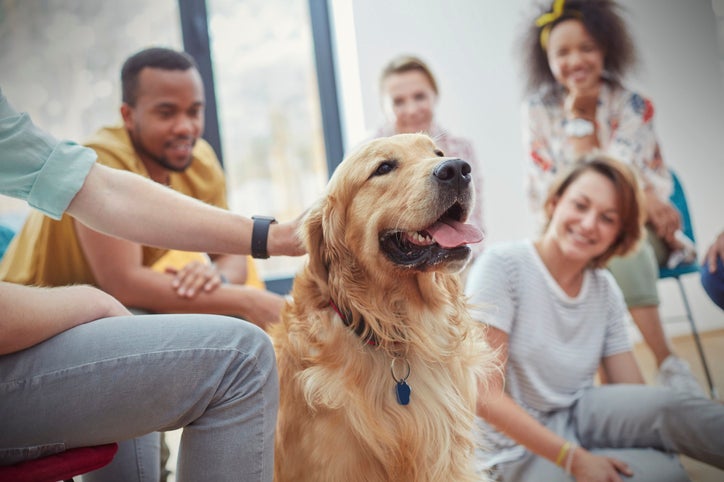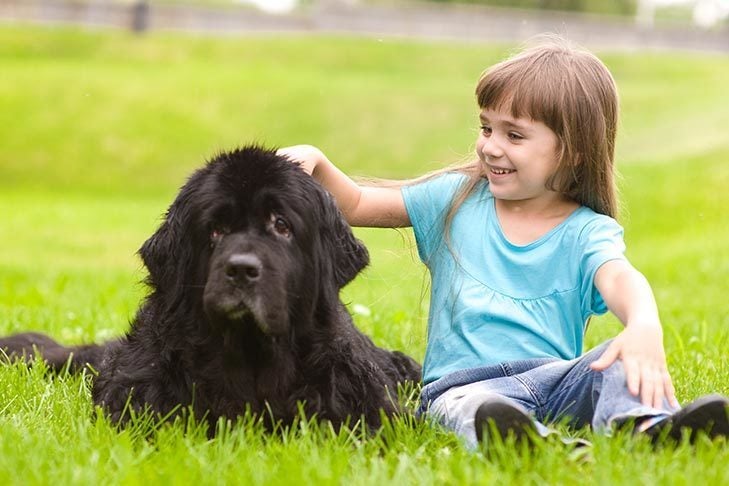
What’s the first thing you do when you see a cute dog? Pat them on the head! After all, it’s the closest body part within reach and those puppy dog eyes are irresistible. It’s also a gesture of fondness for us. But while we might stroke someone’s hair or cheek to show them we love them, dogs don’t speak the same love language as us. They’d likely far prefer we show our affection in a different way. Still, teaching your dog to tolerate head pats will go a long way to helping them cope with this unwelcome human interaction.
Why Dogs Dislike Head Pats
You might ask, “Why does my dog duck when I pat them on the head?” Well, in dog language, a direct stare or looming over another dog is considered a threat. Therefore, when humans do these behaviors, it makes dogs uncomfortable or downright anxious. And of course, leaning over a dog to pat them on the head accomplishes both staring and looming all in one intimidating, albeit well-intentioned, gesture. Plus, a hand coming directly at their face is an invasion of personal space. No wonder dogs duck!

How to Know if Your Dog Doesn’t Like Head Pats
Although some dogs tolerate head pats, most instinctively feel uncomfortable when a hand reaches down from above their head. If you scroll through social media, you’ll easily see examples of distressed dogs suffering through pats on the head. To verify how your pet feels, look at your dog’s body language. Chances are you’ll see signs of stress. Things to look for include:
- Lowering their head or ducking away from your touch
- Walking away
- Pinning back their ears
- Licking their lips
- Yawning
- Showing the whites of their eyes (known as whale eye)
Preventing People From Patting Your Dog on the Head
Well-meaning strangers on the sidewalk or visitors to your home are likely to pat your dog on the head. We humans just can’t seem to help ourselves. But you need to advocate for your dog’s well-being. Ask people to pat your dog on the places you know they enjoy best. For many dogs, the chest, shoulders, chin, or sides of the neck are a safe bet. If the person does not respect your request, don’t be afraid to step in and stop the interaction. Your dog needs to know you have their best interests at heart.

It can also help to have your dog face you instead of the greeter. That will put your dog’s back closer than their head. If the person does stretch over to pat your dog’s head, at least it’s coming from behind, so your dog won’t find it as stressful as a direct approach. Make sure your dog sees the stranger first to avoid startling or scaring them. It can also be helpful to have the greeter approach our dog at a peripheral angle, rather than head on, and to feed your dog treats while they’re being pet.
But how do you turn your dog around? Many dogs will turn to face you when you request a sit, especially if that’s the position you usually reinforce with rewards. You can also use a “touch” cue. “Touch” tells your dog to bump the palm of your hand with their nose, so by moving your hand as you give the cue, you can adjust your dog’s position. A “watch me” cue can also help turn your dog around as they seek out eye contact with you.
Teaching Your Dog to Tolerate Head Pats
It can be challenging to prevent other people from patting your dog on the head. Plus, it’s harder to handle a head-shy dog. For example, it can be difficult to put on their collar or administer eye drops. Therefore, do yourself and your dog a favor and teach them to tolerate head pats. The best way to accomplish this is with desensitization and counterconditioning. Desensitization gets your dog used to something at a low level then slowly increases the intensity, and counterconditioning pairs something your dog dislikes with something they find delightful. When used together, they can change your dog’s response to head pats from negative to positive.
Although you can use toys or games, it’s far more efficient to use delicious treats for this process. Think chicken or steak, not kibble or cookies. Your dog should believe they hit the jackpot. Then, starting at a level of head pats your dog can tolerate, follow each pat with treats – the pat should predict the treat, not the other way around. And only increase the intensity once your dog is happily anticipating their treat after each pat. The following steps will demonstrate this procedure:
- While sitting at your dog’s level, slowly reach your hand toward their head. Then pull your hand back and feed your dog some food.
- Once your dog is looking forward to seeing your hand because they know it predicts food, gently and briefly touch your dog’s head. Then remove your hand and feed your dog some food.
- Once your dog is comfortable with a brief pat, add a second gentle pat. Repeat the process until you can pat several times before presenting the food.
- Now it’s time to increase the pressure of the pats. Go back to a single pat and repeat the above with more intensity.
- Once your dog is happily anticipating a couple of firm pats, it’s time to change your position, so you are coming from above your dog. Stand up and repeat all the steps from simply reaching for your dog to finally patting firmly several times.

It might take several weeks to work through these steps. Aim for a few short sessions each day and be sure not to force your dog past their comfort level, to avoid setting back their progress. And depending on your dog, you might need to break the process down into even smaller steps. Don’t hesitate to enlist the help of a professional dog trainer or animal behaviorist if your dog’s attitude doesn’t seem to be changing.
Check With Your Veterinarian
If your dog has learned to tolerate head pats or was never bothered by them in the first place, take notice if that attitude changes. A sudden shift in behavior can indicate a health issue. It might be that your dog is sick or in pain and therefore unable to put up with uncomfortable situations. This can be of particular concern for senior dogs who can have arthritis or other conditions that cause chronic discomfort. If you notice your dog has suddenly developed issues with head pats, get them to your veterinarian as soon as possible to rule out underlying health conditions.

